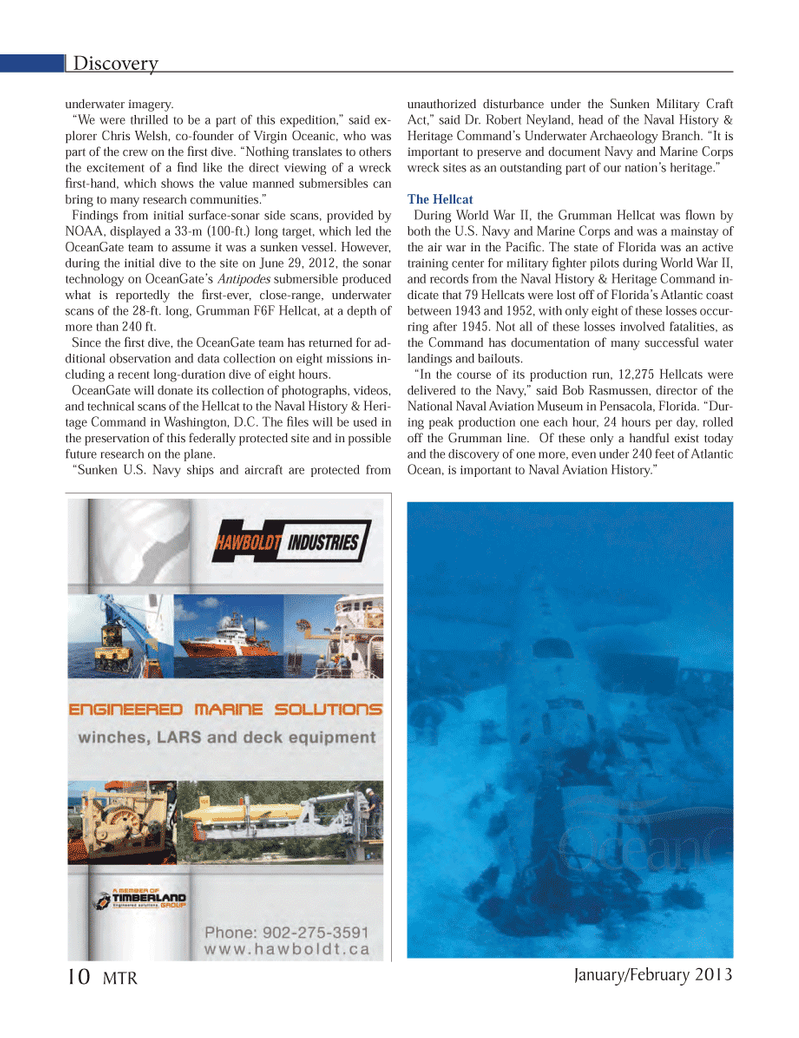
Page 10: of Marine Technology Magazine (January 2013)
Subsea Vehicle Report: Unmanned Underwater System
Read this page in Pdf, Flash or Html5 edition of January 2013 Marine Technology Magazine
underwater imagery. ?We were thrilled to be a part of this expedition,? said ex- plorer Chris Welsh, co-founder of Virgin Oceanic, who was part of the crew on the rst dive. ?Nothing translates to others the excitement of a nd like the direct viewing of a wreck rst-hand, which shows the value manned submersibles can bring to many research communities.? Findings from initial surface-sonar side scans, provided by NOAA, displayed a 33-m (100-ft.) long target, which led the OceanGate team to assume it was a sunken vessel. However, during the initial dive to the site on June 29, 2012, the sonar technology on OceanGate?s Antipodes submersible produced what is reportedly the rst-ever, close-range, underwater scans of the 28-ft. long, Grumman F6F Hellcat, at a depth of more than 240 ft. Since the rst dive, the OceanGate team has returned for ad- ditional observation and data collection on eight missions in- cluding a recent long-duration dive of eight hours. OceanGate will donate its collection of photographs, videos, and technical scans of the Hellcat to the Naval History & Heri- tage Command in Washington, D.C. The les will be used in the preservation of this federally protected site and in possible future research on the plane. ?Sunken U.S. Navy ships and aircraft are protected from unauthorized disturbance under the Sunken Military Craft Act,? said Dr. Robert Neyland, head of the Naval History & Heritage Command?s Underwater Archaeology Branch. ?It is important to preserve and document Navy and Marine Corps wreck sites as an outstanding part of our nation?s heritage.? The HellcatDuring World War II, the Grumman Hellcat was own by both the U.S. Navy and Marine Corps and was a mainstay of the air war in the Paci c. The state of Florida was an active training center for military ghter pilots during World War II, and records from the Naval History & Heritage Command in- dicate that 79 Hellcats were lost off of Florida?s Atlantic coast between 1943 and 1952, with only eight of these losses occur- ring after 1945. Not all of these losses involved fatalities, as the Command has documentation of many successful water landings and bailouts. ?In the course of its production run, 12,275 Hellcats were delivered to the Navy,? said Bob Rasmussen, director of the National Naval Aviation Museum in Pensacola, Florida. ?Dur- ing peak production one each hour, 24 hours per day, rolled off the Grumman line. Of these only a handful exist today and the discovery of one more, even under 240 feet of Atlantic Ocean, is important to Naval Aviation History.? Discovery Photo: Courtesy of OceanGate, Inc. January/February 2013 10 MTRMTR #1 (1-17).indd 10MTR #1 (1-17).indd 102/1/2013 3:22:21 PM2/1/2013 3:22:21 PM

 9
9

 11
11
